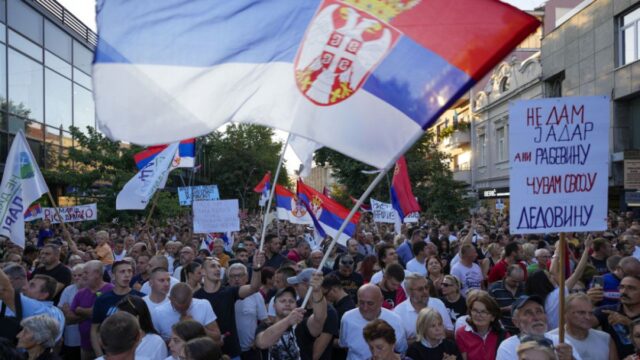This weekend, environmental groups will protest massively in the streets of Belgrade over the planned opening of a lithium mine. Why is it so important for Europe to bring the production of this mineral closer?
Environmental groups in Serbia have called for what they hope will be a massive protest in Belgrade on Saturday (August 10) against plans to open the largest lithium mining operation in Europe in the fertile Jadar Valley, in the west of the country, while China, the third largest producer in the world, also seeks to gain a foothold in the region.
The Serbian mining project has been a source of growing unrest since the Anglo-Australian mining conglomerate Rio Tinto first discovered deposits of a new mineral that it baptized ‘jadarite’ 20 years ago, but tensions reached a peak in January 2022, when the Government of President Aleksandar Vucic withdrew the approval of the mining project.
That decision came after months of protests due to fear of the environmental impact of the exploitation, which the company estimates could be produced annually about 58,000 tons of lithium carbonate (the form in which it is widely marketed, equivalent to about 11,000 tons of pure lithium metal).
Available estimates suggest that a typical 60 kWh electric car battery requires about 50 kg of salt (containing 9.4 kg of pure lithium), which is enough for more than a million vehicles of this type.
Europe wants to extract lithium closer to home
With electric vehicles accounting for a growing share of annual auto sales (14.6% of the 10.5 million units sold last year in Europe, according to trade association ACEA), the market value of lithium carbonate is expected to increase, although prices appear to have stabilized for now around $13 per kilo, after quintupling in 2022.
Analysts at BMI, part of the Fitch Group known for its credit ratings, forecast at the end of June a more modest risealthough significant, of just over $15 this year and $20 in 2025, as increased production will largely satisfy demand.
But the price on the world market it’s not the only reason why Europe wants to extract it closer to home: it wants to avoid dependence on large external suppliers in a time of rising geopolitical tensionsas clearly reflected by the national production and recycling objectives of the recent Critical Raw Materials Law (CRM).
The world’s largest supplier is, by far, Australiawhose 88,000 tons of lithium almost doubled that of the second, Chilelast year (the EU established a strategic partnership with the antipodean mineral giant shortly before with Serbia).
China invests in production in Australia
China produced about 33,000 tons of lithium last year. Tianqi, a Chinese company listed among the top four global lithium minershas invested heavily in production in Australia.
In an interview last month with the South China Morning Post, its CEO, Frank Ha Chun Shing, stated that the company was in talks with possible European partners to expand battery production.
China’s Eve Power began hiring in March to its new 1 billion euro battery plant in eastern Hungary, while Chinese carmaker BYD announced its first European electric car production plant in the same country at the end of last year. More recently, he announced that he would open a similar facility in Türkiye).
With the recent EU tariffs on imports of Chinese electric vehicles As a possible sign of what is to come, Chinese companies have a clear incentive to locate production closer to the European market.
At the moment, lithium production plans in the EU are on holdand the ambitions of its only major producer, Portugalwhich produced about 380 tons last year, of greatly increase production They are also hampered by public opposition and, more recently, accusations of corruption.
This brings us back to Serbia, whose reserves, according to an American geological study, amount to 1.2 million tonscompared to 270,000 in Portugal. Germany has 3.8 million tons, according to the US government agency, and the Czech Republic has 1.3 million, raising interesting questions about assumptions regarding public acceptance of lithium mining too close to home.
A show of force
On 19 July, the EU signed a memorandum of understanding with President Vucic at a RCM summit in Belgrade, which was also attended by the chancellor of the European automobile superpower, Germany. Just three days earlier, the Serbian Government restored Rio Tinto’s license, unfreezing the mining project.
The protesters had mobilized even before the Supreme Court ruling of July 11, which served as a pretext for the Executive’s turn, and which opponents of the mining plan They saw clearly how a foregone conclusion.
The “strategic partnership between the EU and Serbia on sustainable raw materials, battery value chains and electric vehicles” triggered a new round of protests which looks set to culminate in what organizers hope will be a show of force this weekend.







